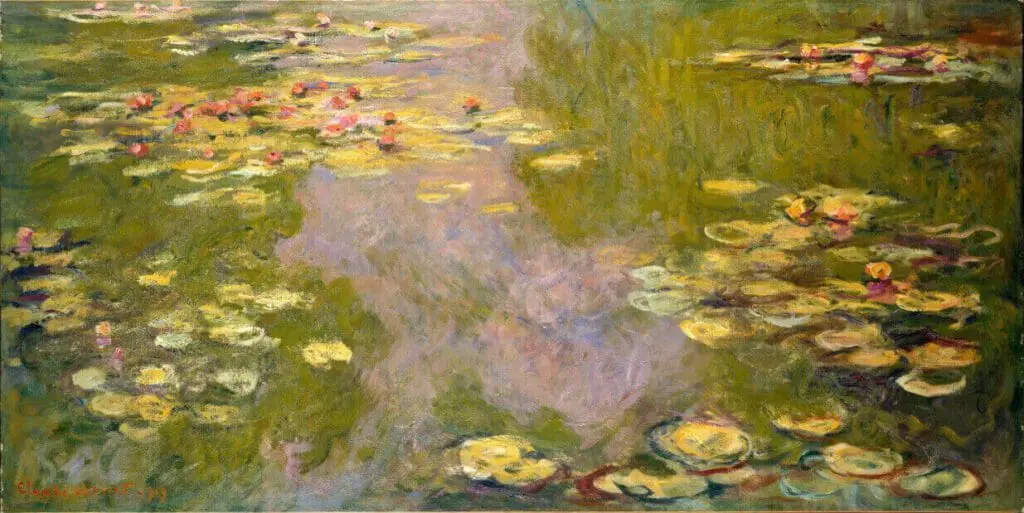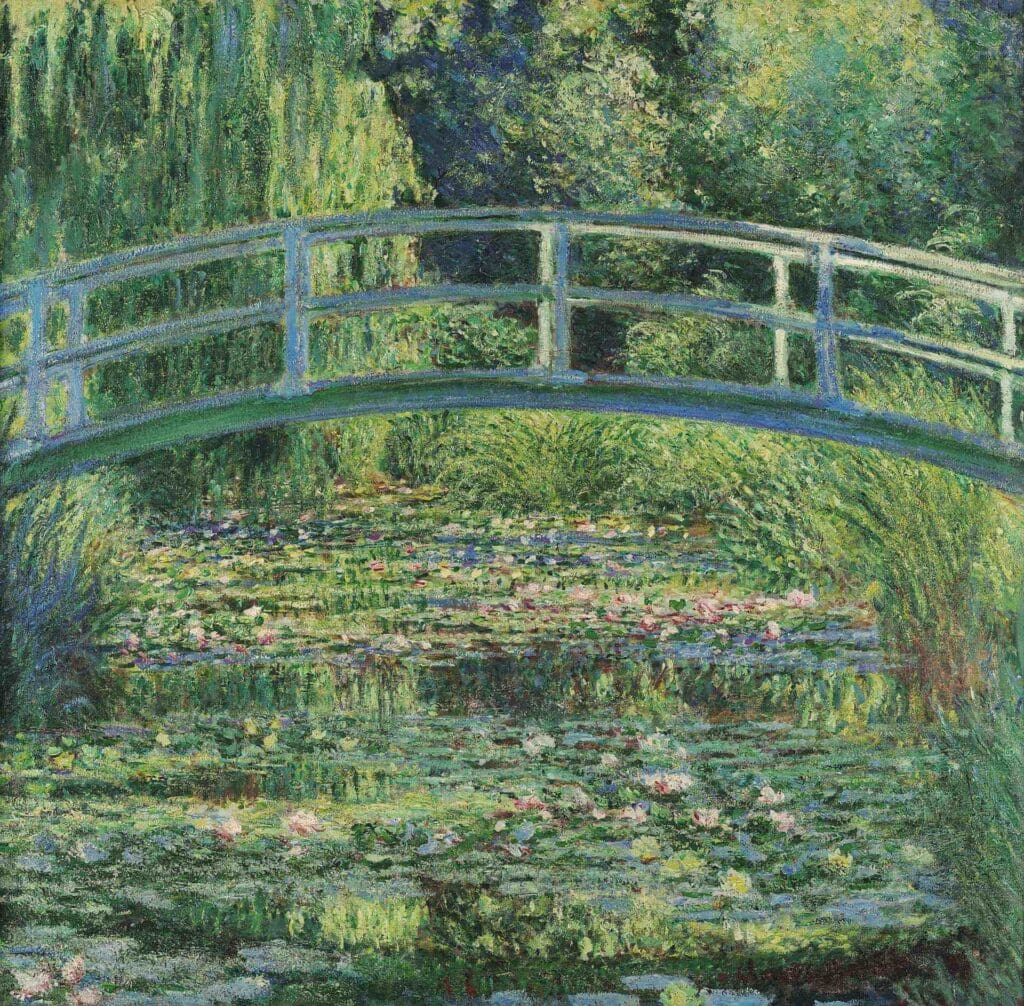When most people think of Claude Monet, most think about his painting series, The Water Lillies. The Water Lilies painting is not just one painting but a series of paintings he painted.
Claude Monet’s Water Lilies series is one of Claude Monet’s most significant series of paintings. These paintings show how Claude Monet immersed himself in nature and studied light. The series evolved and showed the changes in nature and Claude Monet’s artistic evolution.
Table of Contents
- The Birth Of The Water Lilies Series
- The Water Lilies Is About Immersion In Nature
- Claude Monet And The Evolution Of The Series
- Claude Monet’s Legacy Explored
- 6 Reasons The Claude Monet Water Lilies Series Is Significant
- Related Questions
The Birth Of The Water Lilies Series
In the late 19th century, Claude Monet’s fascination with capturing the essence of nature in his artwork led him to transform the gardens surrounding his home in Giverny into a haven of beauty and inspiration.
Monet meticulously designed the gardens, filling them with flowers, plants, and trees. During this time, he discovered the remarkable beauty and potential of the water lilies that grew in the ponds on his property.
The Water Lilies Is About Immersion In Nature
Immersing himself in the natural environment of his gardens, Monet would spend countless hours observing the interplay of light and color on the water’s surface. He became captivated by the ever-changing reflections and the vibrant hues that emerged as the light danced on the lily pads.
Monet’s passion for capturing the fleeting qualities of light and color became the driving force behind his Water Lilies series. That is why you can see his sensitive observations of nature and light with his water lily series.
The Water Lily And Claude Monet’s Exploring the Essence Of Light
The Water Lilies series marked a significant departure from Monet’s earlier works. Instead of focusing on landscapes or scenes of daily life, he shifted his attention to the subtle nuances of light and its interaction with water and vegetation. Monet aimed to capture the essence of light itself, not merely the objects it illuminated.
Through his meticulous brushstrokes and carefully chosen color palettes, he sought to convey the ephemeral qualities of light and the atmospheric effects it created.
Claude Monet And The Ever-Changing Beauty Of Nature
Monet’s Water Lilies series is renowned for its ability to evoke a sense of tranquility and serenity. The paintings invite viewers to immerse themselves in the scene’s peacefulness.
The artist’s careful observations and meticulous renderings of the water’s surface, the reflections, and the delicate water lilies transport the audience into a world of natural beauty. Monet’s ability to capture the fleeting nature of light and the ever-changing rhythms of the natural world is truly remarkable.
Claude Monet And The Evolution Of The Series
The Water Lilies series evolved as Monet’s artistic style and vision matured. Initially, he focused on creating smaller-scale paintings, capturing intimate views of the water lilies and their reflections.
Monet’s approach expanded as the years went by, and he began working on larger canvases, allowing him to explore the immersive experience of being surrounded by the water lilies. The later paintings in the series became more abstract, with bold brushstrokes and a greater emphasis on capturing the essence of light and color.
Claude Monet’s Legacy Explored
Monet’s Water Lilies series showcases his artistic brilliance and deep connection to nature. Through these paintings, he invites us to appreciate the beauty and serenity found in the natural world.
The series also paved the way for future artists to explore abstraction and the expressive power of color and light. Monet’s dedication to capturing the essence of light and his ability to create a sense of harmony and tranquility in his artwork continues to inspire artists and art lovers alike.
The Influence Of Claude Monet’s Water Lilies Series
The Water Lilies series remains one of Monet’s most celebrated and influential bodies of work. Its impact on the art world cannot be overstated.
The series challenged traditional notions of representation and opened the door to new possibilities in abstract art. Artists in subsequent generations, such as the Abstract Expressionists, found inspiration in Monet’s exploration of color, light, and mood.
The Water Lilies series continues to captivate audiences and serves as a testament to the enduring power of art to evoke emotion and transcend the boundaries of time.
6 Reasons The Claude Monet Water Lilies Series Is Significant
Claude Monet’s Water Lilies series not only solidified his reputation as a master of Impressionism but also left a lasting legacy in the art world. His innovative approach to capturing light, color, and the essence of nature set him apart from his contemporaries and continues to inspire artists today.
Impressionism And Beyond
Monet’s Water Lilies series was crucial in developing the Impressionist movement. Alongside artists like Renoir, Degas, and Pissarro, Monet pushed the boundaries of traditional artistic techniques.
His focus on capturing the transient qualities of light and atmosphere influenced generations of artists, leading to post-impressionism and other artistic movements.
The Power Of Abstraction In Art
As Monet continued to explore the Water Lilies theme, his paintings became increasingly abstract. The loose brushwork and bold color choices paved the way for future abstract artists who embraced the expressive power of non-representational art.

Monet’s willingness to depart from strict representation opened doors for artists to explore emotion, mood, and subjective experience.
Environmental Awareness And Monet’s Art
Monet’s deep connection with nature is evident throughout the Water Lilies series. His dedication to capturing the beauty of his garden and the delicate balance of the natural world serves as a reminder of the importance of environmental preservation. Today, Monet’s work inspires artists and individuals to appreciate and protect the environment.

Museums And Exhibitions And Monet’s Water Lilies
Monet’s Water Lilies paintings are housed in renowned museums worldwide, including the Musée de l’Orangerie in Paris, the Museum of Modern Art in New York, and the Musée d’Orsay in Paris.
These institutions showcase Monet’s work, ensuring its accessibility to a broad audience and preserving it for future generations.
Artistic Exploration And Monet’s Water Lilies Series
Monet’s commitment to exploring a single subject in various forms and lighting conditions is a testament to the value of artistic experimentation. His dedication to capturing the ever-changing qualities of light and nature encourages artists to push boundaries and challenge themselves in their artistic practices.

Emotional Impact And Claude Monet’s Water Lilies
The Water Lilies series has a profound emotional impact on viewers. Monet’s ability to evoke a sense of peace, tranquility, and harmony in his paintings resonates with audiences across generations.

The series invites viewers to immerse themselves in a world of beauty and contemplation, providing an escape from the chaos of everyday life.
Claude Monet’s Water Lilies series represents a pinnacle in his artistic career and a milestone in the development of modern art. Through his meticulous observations of nature, Monet created a body of work that continues to captivate audiences with its vibrant colors, atmospheric effects, and profound emotional impact.
The series not only showcases Monet’s technical skill and innovation but also serves as a timeless reminder of the beauty and fragility of the natural world. As we contemplate the Water Lilies, we are transported to serenity, where light, color, and nature intertwine perfectly.
Anita Louise Art is dedicated to art education, great artists, and inspiring others to find and create their art. We love art that uplifts and inspires. #ArtToMakeYouSmile! #ArtToMakeYouHappy!
If you want to see any of my art, you can find out more by clicking here. If you are interested in what inspires me and my paintings, you can discover more by clicking here.
We have a free newsletter and would love you to be part of our community; you can subscribe to the newsletter by clicking here. If you have any questions, I would be happy to talk to you any time. You can reach me, Anita, by clicking here.
Subscribe to our Anita Louise Art YouTube Channel with great videos and information by clicking here.
Related Questions
What Was The Impact Of Vincent Van Gogh On The Art World?
Van Gogh used color, form, and emotions in his art. He had a bright palette that was individualized for his time. Even though he did not see a lot of success during his life after he died, the impact of his art can be seen in both the Expressionism and Fauvism movements that were taking place in Europe.
By clicking here, you can learn more by reading What Was The Impact Of Vincent Van Gogh On The Art World?
Similarities Of Claude Debussy And Claude Monet
Claude Debussy and Claude Monet are both artists, but one is a musical composer, and the other is an artist. They are both considered Impressionists and were not afraid to break from the tradition of their day to create something new. Their work was considered to be a bold change for the days.
You can discover more by reading Similarities Of Claude Debussy And Claude Monet by clicking here.
Claude Monet And His Art Work
Claude Monet was one of the more prolific and consistent Impressionism painters. He was a great believer in painting what is in nature and the changing light. He was an en Plein air painter. He is known for his strong and bold color and short brush strokes.
You can discover more by reading Claude Monet And His Art Work by clicking here.


